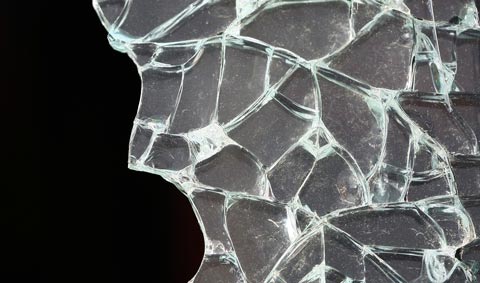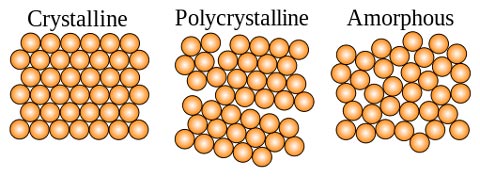Shattering Science and Glass Physics
From windshields to coffee tables to high-rise office buildings, we are surrounded by glass. But as any action movie stunt double will tell you, glass will break when you slam into it with enough force. Sometimes it breaks with devastating consequences, creating jagged shards that spray out in all directions.
This can make a bad situation, like an automobile collision, much worse. High-risk applications like car windshields require a balance: glass that not only resists scratching and breaking but also breaks safely under an overwhelming force.

Glass is strong but shows potential to be stronger, according to theoretical work by researchers at Rice University.
Image Credit: Rice University
How strong can glass get?
In a recent theoretical study at Rice University, Peter Wolynes and his graduate student Apiwat Wisitsorasak explored the physical limit of the strength of glass. They found that you may be able to double the strength of glass just by changing how it is made! Stronger glass could lead to more durable screens for electronic devices, safer window panes, and more effective protection for emergency responders and the military.
The study was based on a mathematical model of how glass forms that Wolynes developed more than twenty years ago. Wolynes hadn’t applied the model to glass strength until now, however. With some modifications to the model, the scientists were able to accurately predict the ultimate strength of any type of glass.
Glass has some unusual properties. The molecules in warm glass behave just like a liquid — randomly flowing and vibrating. When cooled, the glass molecules freeze in place, similar to the molecules in a normal solid, but there’s one important difference. In a normal solid, the molecules freeze in a regular, crystalline pattern. In glass, the molecules freeze in a random arrangement.
The strength of a particular type of glass depends on the bonds between the molecules in the glass. These bond strengths can vary with different materials and manufacturing techniques, according to Wolynes’s theory.

The different molecular structures for crystals (crystalline), solids containing many microscopic crystals (polycrystalline), and amorphous solids like glass.
Image Credit: Cdang via Wikimedia Commons.
Glass is traditionally made by fusing together silica (which comes from sand), sodium carbonate (which lowers the melting point of the silica), and calcium oxide (also known as lime, which makes the glass more chemically stable) at high temperatures. Manufacturers cool the glass by a few hundred degrees, work it into the desired shape, and then slowly cool the glass to a solid through a process called annealing.
According to calculations by Wolynes and Wisitsorasak, manufacturers are pushing this technique to its limits for producing strong glass. However, the study suggests that much stronger glass could be made with a different technique.
The suggested technique resembles Chemical Vapor Deposition (CVD) — a highly controlled method used to make thin films for microelectronics and nanotechnology applications. It involves vaporizing carefully chosen chemical compounds and exposing them to a substrate, or surface. The compounds then react with the surface, creating a thin deposit of the desired material on the surface.
During regular glass formation, extra energy is trapped in the glass by the temperature transitions of the annealing process. Wolynes and Wisitsorasak suggest that using a vapor deposition process would result in stronger glass because it would eliminate this extra energy. Experimental scientists still need to determine how well this process works, but the theoretical results look promising.
Shattering Safely
Stronger glass addresses one aspect of the glass safety issue, but all glass is destructible. Inevitably, even very strong glass will break under too much force, and this breaking can release huge amounts of energy capable of causing serious damage and injury. To prevent this, manufacturers use two main techniques for designing glass that breaks more safely:
- Laminated glass: The glass commonly used in windshields and high-rise windows is made by sandwiching a sheet of polyvinyl butyral (PVB) plastic between two or more pieces of glass and bonding them together under heat and pressure. Not only does this make the glass harder to break, but if the glass is broken, the broken pieces stick to the PVB.
This is why in movies — and in real life — shattered windshields look like a spider web of broken pieces that don't fall out, or if they do fall out, the whole windshield pops out in one piece. This property of laminated glass significantly reduces the risk of people being hurt from flying shards.
- Toughened or tempered glass: The glass used in shower doors and furniture undergoes a special heating and cooling process that strengthens the glass by five to 10 times. The tempering also reduces injuries--tempered glass shatters into tiny chunks instead of breaking into long, jagged splinters, reducing the severity of injuries.
A slow-motion video of tempered glass partially shattering.
Video Credit: Discovery HD
Scientists and engineers are constantly combining techniques and tuning the properties of materials to optimize glass for different applications. For example, modern bullet-proof glass combines laminated glass and tempered glass with polycarbonates and thermoplastic. Laminated glass can be designed to reduce noise transmission or save energy by altering the properties of the plastic layer.
Glass can also be made with self-healing coatings to protect itself from scratches and other cool features. By combining these techniques with new methods for developing stronger types of glass, scientists have the potential to make glass an even more versatile, safe, and useful material than what we already enjoy.
References and Links
Rice University: Glass half full: Double-strength glass may be within reach
Read more about the study by Wolynes and Apiwat Wisitsorasak. This article also links to a copy of their technical paper published in the Proceedings of the National Academy of Sciences.
Corning Incorporated: Corning Museum of Glass
Explore the history of glass, types of glass, and current glass research through the museum’s online exhibits
HowStuffWorks: What makes glass transparent?
Learn more about the properties of glass and what makes it useful for so many applications.
HowStuffWorks: How does safety glass work?
Read more about laminated and tempered glass and the benefits and uses of each.
—Kendra Redmond














